As a mid-tier publisher, you’ve outgrown basic affiliate strategies but still face the partnership paradox: the brands you want don’t know you exist, while the brands that approve you often underperform.
Scrolling through endless listings and sending applications into the void—it’s a frustration preventing you from accessing the revenue-driving partnerships that could scale your business.
This guide reveals how strategic publishers use impact.com’s discovery tools to flip that dynamic. Instead of chasing brands, you’ll learn to identify high-earning partners actively seeking publishers like you, build a pipeline of aligned opportunities, and create a partnership portfolio designed for consistent growth.
Before you search: Optimize your profile for discovery
Many brands actively browse the impact.com Marketplace to find new partners. They filter by categories like:
- Content vertical (e.g., fashion, travel, tech)
- Audience demographics
- Promotional methods (e.g., blog, YouTube, newsletter)
Having your information clearly laid out allows brands to immediately recognize if you’re a good fit for your program. Here are some key steps you can take.
Add all your media properties
One of the biggest mistakes publishers make is adding only one media property to their profile.
Let’s say you list your blog but don’t mention your YouTube channel. If a brand is looking specifically for YouTube partners, they won’t see you.
So list every channel where you promote affiliate links, and properly tag them.

Content creator Chloe Wen has connected and verified her media properties so brands can see where she can promote them on her profile.
Create a media kit that shows your value
A strong media kit can help you stand out. You don’t need anything flashy, but you do need to clearly show what you offer.
As you build your profile and media kit, ask yourself:
- What makes you different?
- What kind of audience do you reach?
- How do you typically promote your brand partners?
These are the key elements brands want to know before reaching out. Organizing everything in one clear, structured place makes it easier for brands to see your value and increases your chances of receiving quality inbound offers.
Mastering search: 5 ways to find responsive brands in the impact.com Marketplace
Finding brands that match your niche is one thing—finding brands that actually approve and engage with new partners is another. These five strategies will help you find and apply to brands that are both aligned with your audience and likely to say “yes.”
1. Start with the high-potential partners on your homepage
The Marketplace homepage is one of the best places to start your brand search.
Look for:
- Curated collections in the homepage panels
- The brand carousel highlighting featured partners
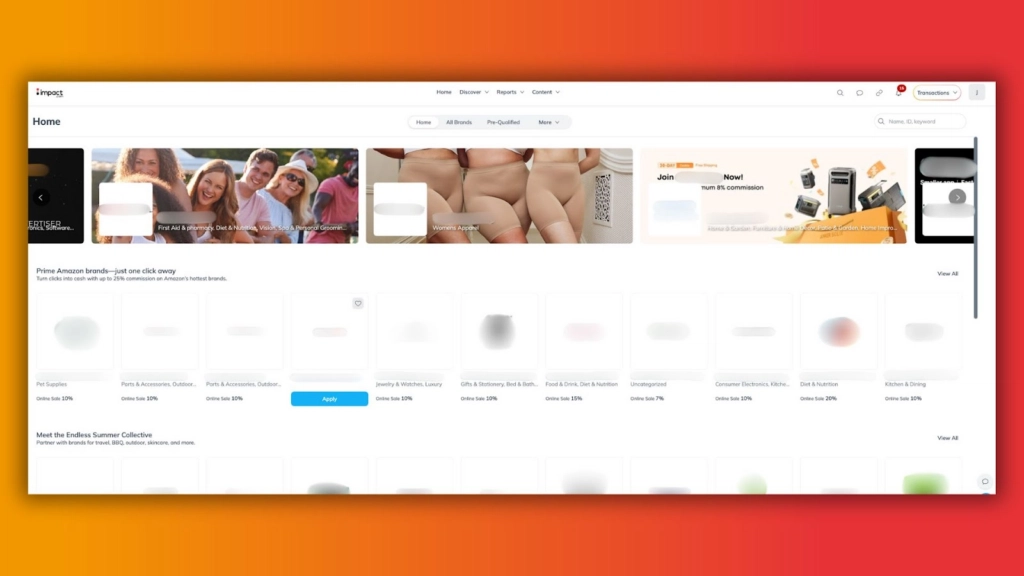
The Marketplace homepage showcases handpicked selections to help you kick off your search.
These spots highlight brands that are actively recruiting and have a higher propensity to approve new partnerships. That’s because many of them have accepted a partnership in the last 90 days, making them more likely to approve new ones.
Some collections are tied to seasonal campaigns—such as Father’s Day or Christmas—while others are based on performance or industry trends. These partners are carefully selected for their engagement and fit with the collection theme, making them an easy starting point for finding compatible partners.

2. Use the “Pre-qualified” filter for instant approvals
If you want to start a partnership right away, the “Pre-qualified” filter is your best friend.
Apply this filter to see brands that will automatically approve you. When you click “Join,” you’re instantly accepted into their program—no waiting or guesswork.
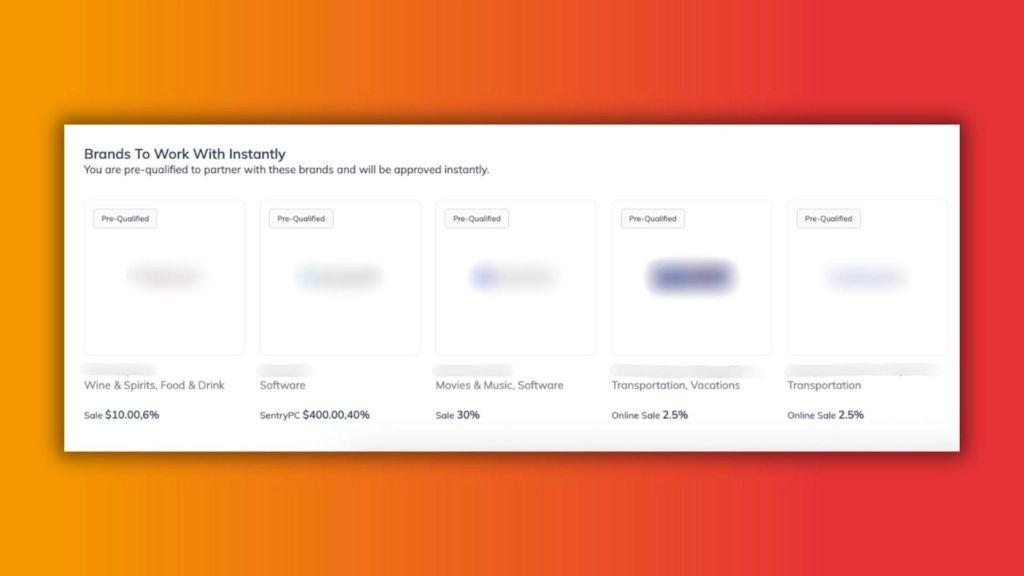
You can find the “Pre-qualified” filter via a collection on your homepage or your Marketplace navigation bar.
This is one of the fastest ways to overcome “application blindness,” where you apply to multiple brands and hear nothing back.
But don’t just join every brand that offers instant approval. Before clicking “Join,” take a moment to review:
- Is their product relevant to your audience?
- Can you see yourself creating strong, long-term content for them?
The goal is to build a portfolio of high-quality, aligned partnerships that actually perform.
3. Dig deeper with advanced search and sorting
The default Marketplace view scratches the surface. But with a few simple steps, you can uncover brands others might miss.
Use your performance data to guide your search
Start by reviewing your “Performance by Category” report. Here, you can see which niches you’re already strong in.
Then, go back to the Marketplace and apply the “Category” filter. This helps you focus your search on brands that align with categories you already know how to monetize.
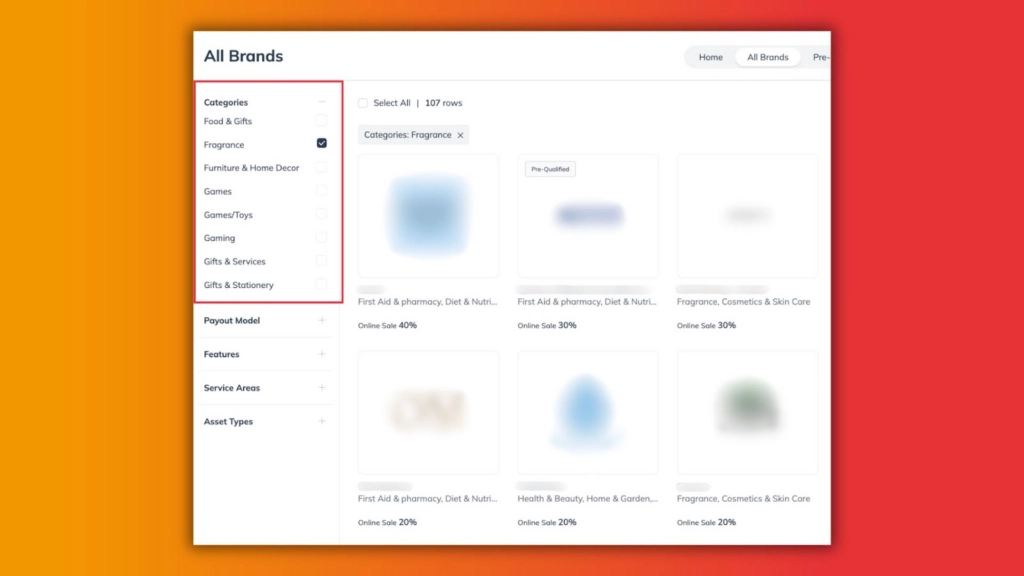
The “Categories” filter offers a wide variety of industries and niches to help you find the right fit.
Think beyond broad categories and consider which sub-niches are driving performance. For example:
- Fashion: Luxury, sustainable, or budget-friendly apparel
- Home and garden: Smart appliances, eco-friendly cleaning products, minimalist decor
- Beauty and wellness: Skincare for sensitive skin, clean beauty, supplements for women
- Tech: Budget tech accessories, wearables, remote work tools
- Fitness: Home workout gear, women’s activewear, recovery tools
- Parenting: Eco-conscious baby products, toddler toys under $50, educational games
Use those insights to refine your brand list and prioritize programs where your content already performs well.
By applying filters based on what categories you’re already performing well in, you improve your odds of finding high-fit partnerships.
Sort by “Newest” to find hidden gems
Want to get in early with brands that are just starting out on the platform? Use the “New” sorting option to see brands that have recently joined.
These brands are often more open to building relationships and eager to grow. They may also have less competition from other publishers.
By combining your own performance data with smart filters and sorting, you’ll find brands that are either statistically a great fit, or brand new and ready to collaborate.
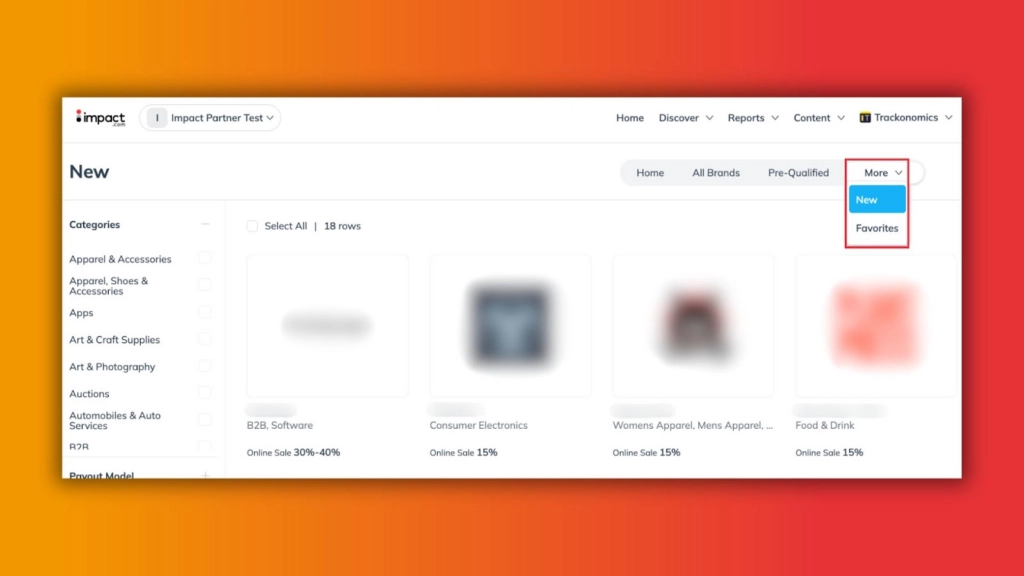
You can find the “New” sorting option in the Marketplace navigation bar.
4. Evaluate brand tiles and profiles for signs of a strong partner
Once you’ve found some potential partners, it’s time to vet them. The Marketplace gives you helpful signals to decide if a brand is worth your time.
Start with the brand tile
Each brand listing includes a response rate percentage. While not always a perfect reflection of responsiveness, a high number is a good sign that they’re likely active and responsive.
Think of it as a quick filter to help you spot brands that actually reply and approve applications.
Keep in mind response and acceptance rates can be a leading indicator of a brand’s activity, but they can be influenced by external factors like seasonality, target audience behavior, or inconsistencies in data collection.
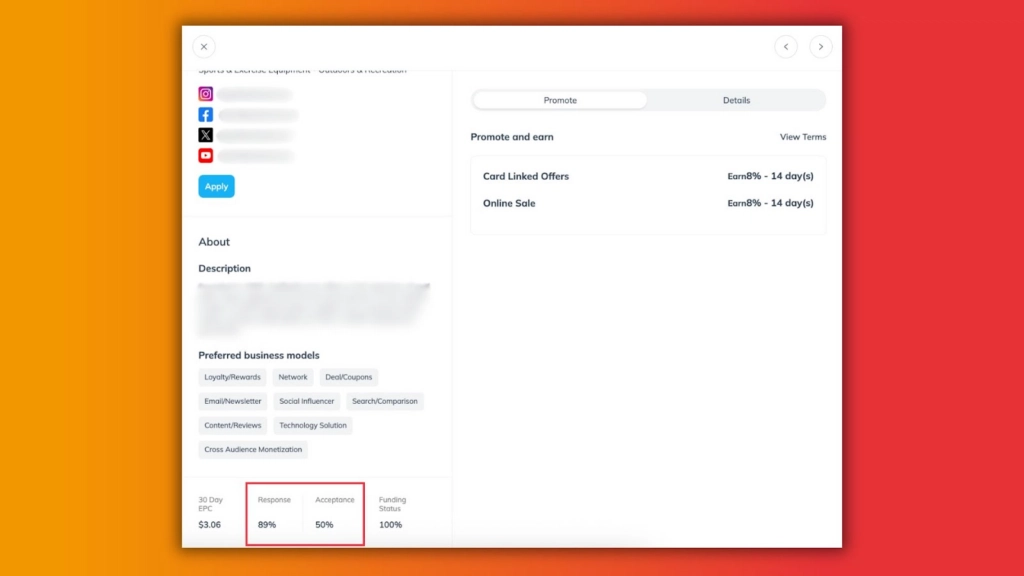
Most brand profiles list a response and acceptance rate that you can reference before applying.
Go deeper on the profile page
Click into the brand’s profile to evaluate their program more closely. Key things to look for:
- Clear program terms: Are the commission rates and policies easy to understand?
- Up-to-date creatives and contact info: Do they provide fresh assets and a reliable contact?
- Brand values and social proof: Take a few minutes to check their website, social media, and customer reviews. This gives you a feel for their brand voice, values, and how their audience responds to them.
A great brand partner should align with your content and your audience. Taking this step helps you avoid short-lived partnerships and focus on ones that can grow over time.
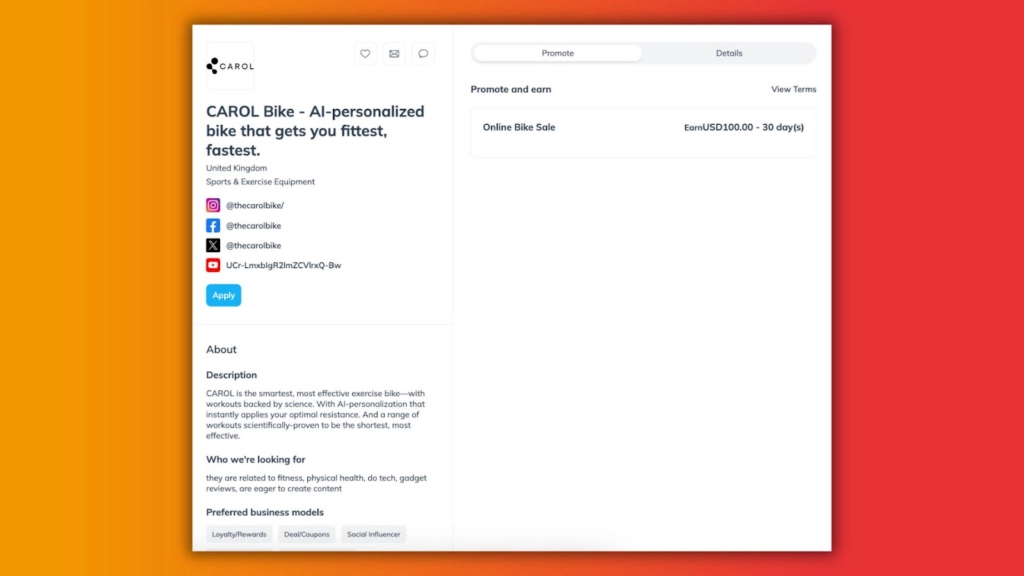
Dig into the brand’s Marketplace profile to gain more insights about the brand and find their other channels for additional research.
5. Opt-in into matchmaking emails
Want one of the easiest ways to discover new brand partners? Let the opportunities come to you.
Make sure you’re opted in to receive impact.com’s weekly merchandising emails, which highlight curated collections of brands based on things like:
- Seasonal campaigns
- Recent brand activity
- Emerging categories or trends
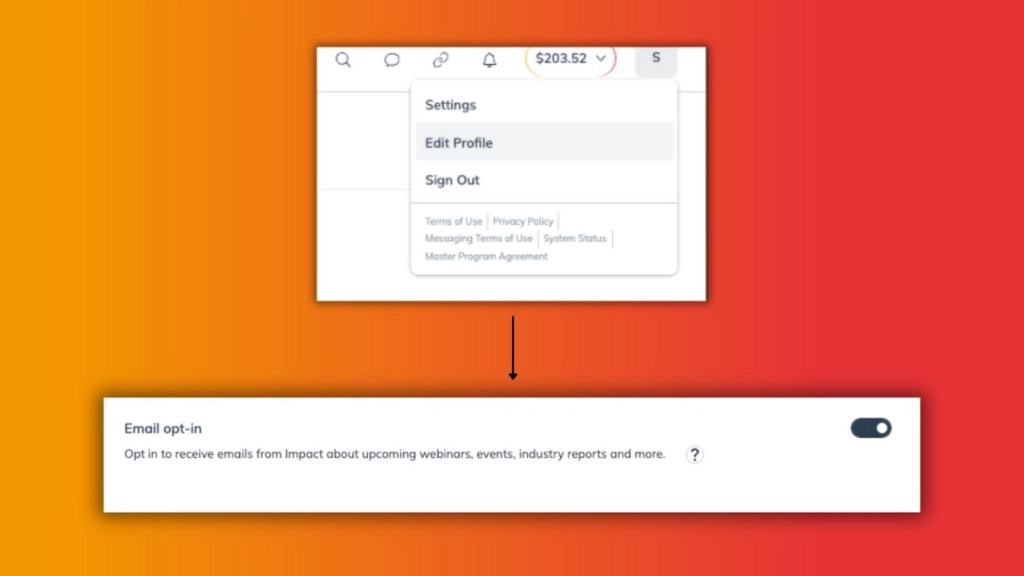
To subscribe, click the user icon, then go to Edit Profile and scroll down to Email Opt-in.
It’s a low-effort, high-reward way to stay informed about active programs and new opportunities.
Even if you’re not actively searching, these emails can spark ideas or surface brands that align with your content but weren’t on your radar yet. Think of it as your weekly nudge to stay strategic and inspired.
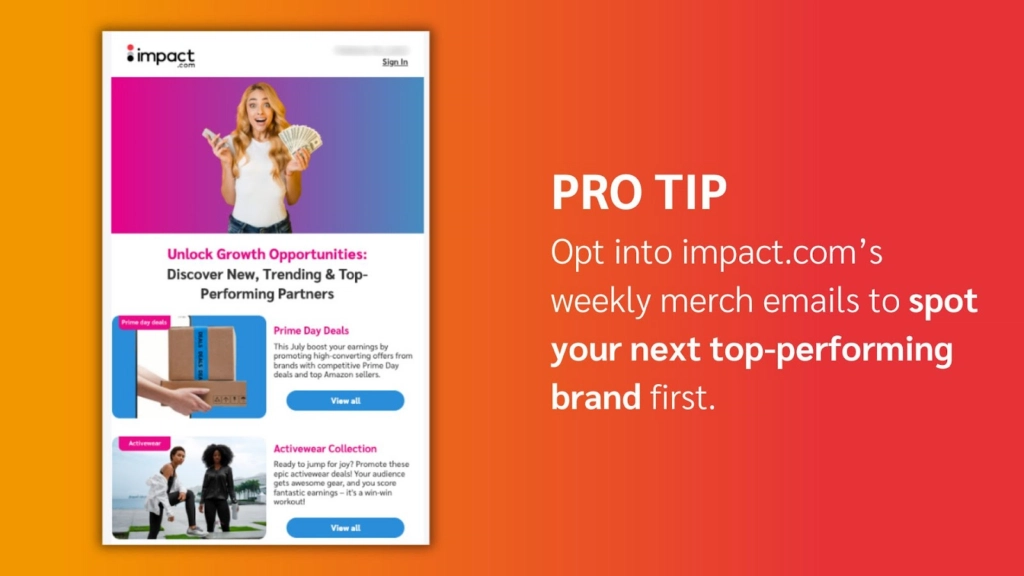
Beyond the brands: 3 ways to uncover hidden gems in the Product Marketplace
If you’re already doing product research for your content, don’t let it go to waste. The impact.com Product Marketplace helps you turn that research into real, revenue-driving partnerships.
It’s one of the best ways to discover emerging or under-the-radar brands that align with what your audience actually cares about.
1. Discover partners based on products your audience already loves
Instead of starting your search with a brand, start with a product type, like “washing machine,” “running shoes,” or “mineral sunscreen.”
Think about what your audience is already asking for in:
- Comments
- DMs
- Emails
- Community forums
What products do they talk about or ask you to review? Use those to help you start your search.
Taking this approach flips the usual search strategy. Instead of chasing brand names, you’re looking for solutions to real audience needs. And brands are far more likely to invest in a partnership when it’s clear you genuinely understand your audience and how their product fits in.

Source: Sprout Social
2. Find trending products and deals to drive conversions
The Product Marketplace is a useful way to spot high-performing, high-converting products in real time.
There are four primary ways to discover products:
- Search bar
- Sort by function, where you can sort products based on total sales value, sales volume, price, and more
- Category filter
- Program relationship filter, such as pre-qualified brands, brands you’re already working with, and other brands
You can also use widgets on the Product Marketplace home page like “Top performing products” to see what’s selling well across the platform.
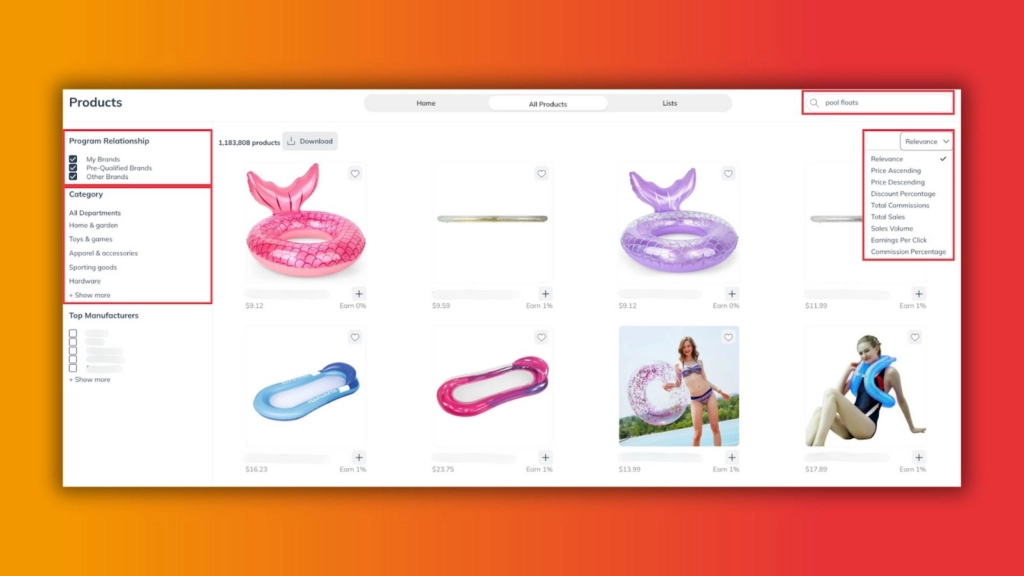
You can access all of these product discovery features right on the search page.
Promoting a great deal is an easy win since it gives your audience instant value and can boost conversions with minimal effort.
But don’t just chase discounts. Always ask yourself if the product genuinely adds value for your audience, or if you’re promoting it for a quick click. Staying audience-first is what builds long-term trust (and commissions).
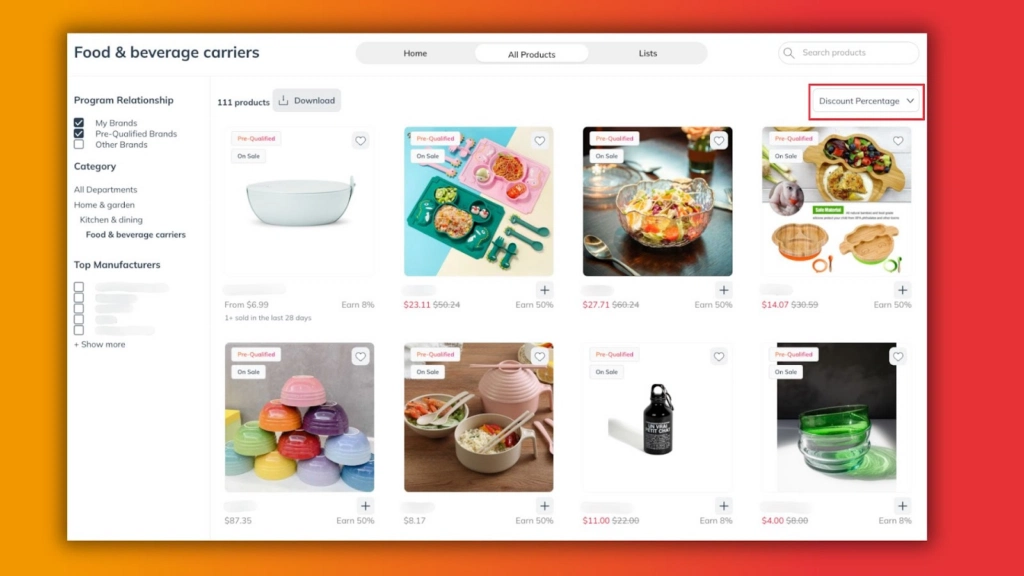
Sorting by discount percentage can surface the best deals in your search or a specific product category.
3. Identify new brand opportunities for a single product
Can’t get into a big retailer’s affiliate program? Don’t give up on the product just yet.
Use the Product Marketplace to search for that exact item. Often, you’ll find that multiple vendors sell the same product or something very similar.
This gives you the chance to:
- Partner with a smaller brand that may be more accessible
- Get pre-qualified for instant approval
- Build a more meaningful partnership
Smaller brands are often eager to work with publishers who can help them grow. If you can show how your content drives results, you become essential to their growth story—not just one of thousands of partners.
These relationships often lead to more collaboration, better support, and stronger long-term revenue than you might get from a major brand alone.
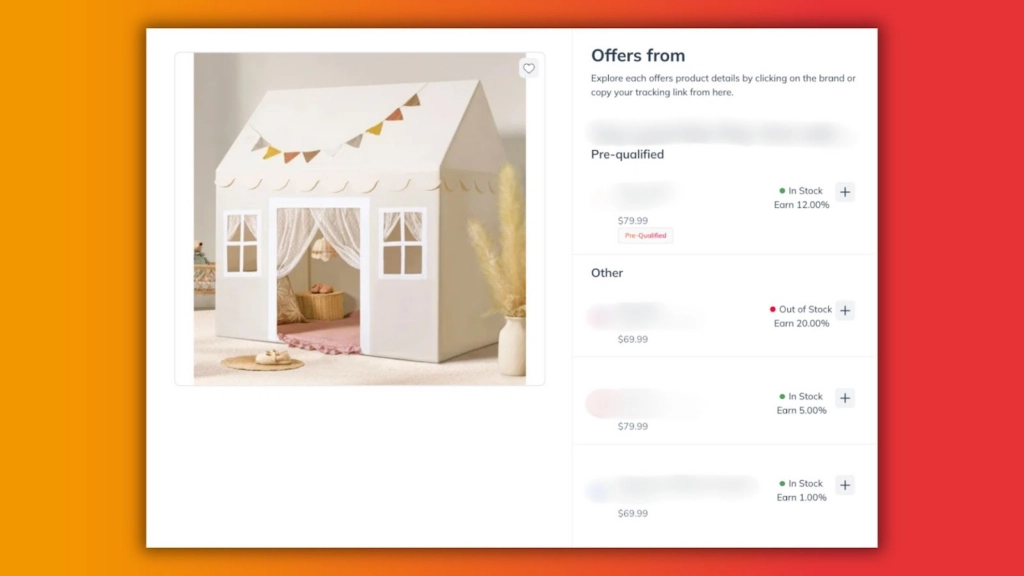
If a product is offered by multiple vendors, compare each brand’s pros and cons and find the best strategic fit for you and your audience.
Collect data to optimize your application approach in the future
Success in the impact.com Marketplace doesn’t just come from good instincts. It also comes from tracking what works, learning from it, and refining your strategy over time.
Phase 1: Systematically track your partnership efforts
Building a simple system to track your applications helps you learn which brands are most responsive and which strategies actually work.
Set up a central tracking sheet
Use a spreadsheet or project management tool to log your:
- Brand name
- Date you applied
- Application status (accepted, rejected, or no response)
Over time, this will help you identify patterns in which brands accept you, what verticals are most responsive, and how your messaging or profile changes impact results.
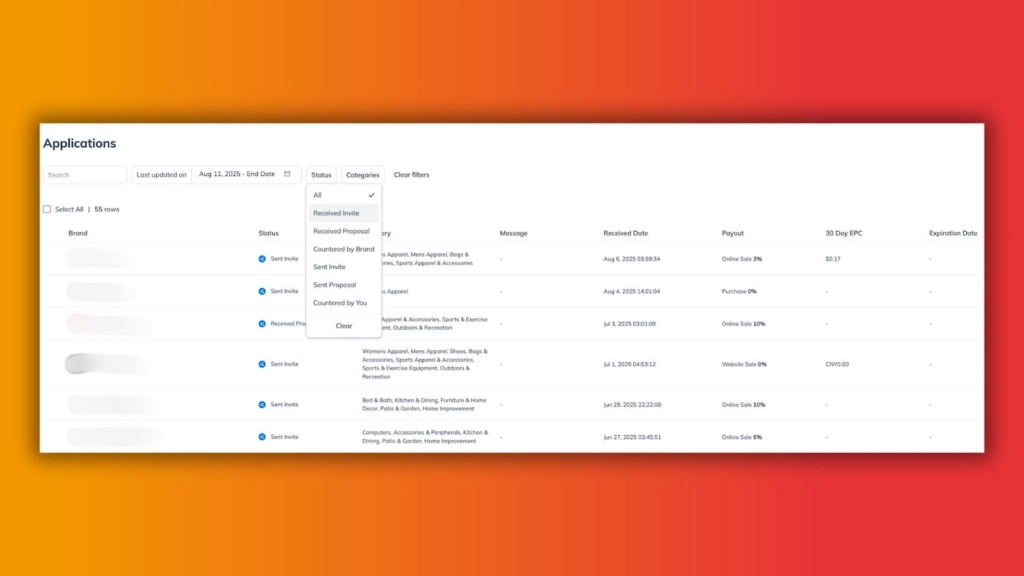
You can also examine your outstanding applications to help inform which brands tend to be more or less responsive to you. To see all of your brand contracts (signed, pending, rejected, and expired), check out the Contract History Report.
Use application data to guide future strategy
Applying to a wide range of brand programs helps you build a dataset, not just a list of rejections or wins. The goal isn’t to apply at random—it’s to apply strategically and spot trends over time.
For example, you might learn that mid-sized wellness brands are much more likely to accept your applications than large retailers. Or that your acceptance rate goes up after updating your profile.

Phase 2: Analyze your performance and show unique value
Once your partnerships are up and running, the next step is to use your data to optimize results and to prove your value to future brand partners.
Track key performance metrics
Make it a habit to review your affiliate performance regularly.
Some of the most useful metrics to monitor are:
- Revenue per view (RPV): This helps you understand which content drives the most revenue, relative to traffic or impressions. It’s a simple but powerful data point you can share with brands to show real impact.
- Conversion trends: Where are people clicking, converting, or dropping off? This insight helps you adjust your strategy and double down on what works.
Create assets that showcase your value
Don’t wait for brands to ask for proof of performance. Build assets that make your value obvious up front:
- Media kit: Include audience insights, performance highlights, and your content verticals.
- Case studies: Use real data to tell a story. Show how your content drove results, and why you’re different from other partners.
Brands are far more likely to engage when you can clearly show how you contribute to their success.
Find and secure better brands in impact.com, faster
Identifying the right brand partners takes more than just scrolling through listings. It takes strategy.
To recap, here’s how to approach your search like a pro:
- Optimize your profile to attract the right brands
- Use smart search and filters to uncover responsive, high-fit partners
- Explore the Product Marketplace to find hidden opportunities
- Track your applications and performance to refine your strategy over time
- Proactively showcase your value with data-driven assets like media kits and case studies
Taking a thoughtful approach helps mid-tier publishers cut through the noise, overcome common frustrations, and build a diverse, resilient portfolio of brand partners. The result is more meaningful collaborations and more scalable revenue on impact.com.
Read more articles about optimizing your partnerships:
- 5 ways publishers can stand out and grow in the impact.com marketplace (blog)
- Your step-by-step guide to creating a Marketplace listing that brands can’t resist (blog)
- Negotiating commissions: How successful publishers broker better contracts with brands (blog)
FAQS
To find top-performing brands, start by checking the curated collections and featured partner carousels on the impact.com Marketplace homepage, as these highlight brands that are actively recruiting partners.
When you search for brands and begin evaluating them, you should also carefully review each brand’s tile in the Marketplace, which shows a response rate to give you a sense of their activity.
Another key strategy is to use the Product Marketplace to spot high-performing items and see what’s selling well across the platform.
For niche websites, it’s crucial to align your brand search with categories you already monetize effectively.
Review your “Performance by Category” report to see which niches are working for you, and then use the “Campaign Category” filter to find brands in those specific areas.
Think beyond broad verticals and dig into the sub-niches that drive your performance, such as “eco-friendly cleaning products” instead of just “home and garden”.
You can also search the Product Marketplace for items your audience is already asking about to find brands that meet their specific needs.
For selecting high-earning affiliate brands, the most effective strategy is to adopt a mindset of building an aligned, high-quality portfolio rather than just joining as many programs as possible.
You should thoroughly vet potential partners by looking beyond their commission rates to evaluate their brand values and social proof, ensuring they are a good long-term fit for your audience.
Always maintain an audience-first perspective by choosing brands that solve a real need or add genuine value, as this is what builds the trust required for long-term commissions. This strategic approach, focused on alignment and value, is key to building a resilient and profitable portfolio.
After joining the impact.com Marketplace, you need to optimize your profile by adding all your media properties and creating a media kit that clearly shows your value to brands.
Next, use the platform’s search and filter functions strategically. Start with the high-potential partners on your homepage and use filters like “Pre-qualified” to find responsive brands.
Before applying, vet the brand’s profile to ensure their program terms are clear and that their values align with your audience.
After applying, track your results in a spreadsheet to identify patterns in approval rates, which can help you refine your strategy for future applications.






